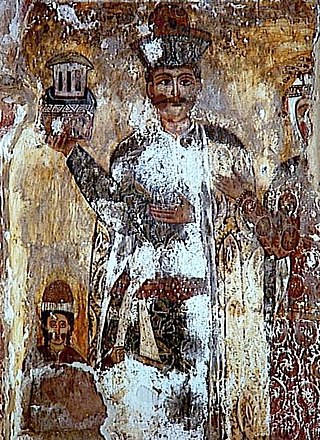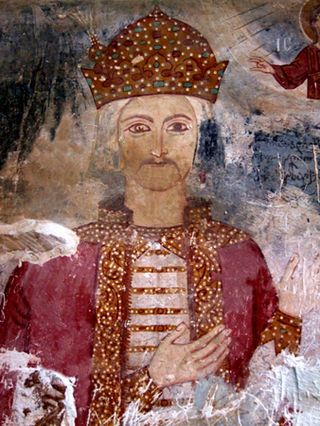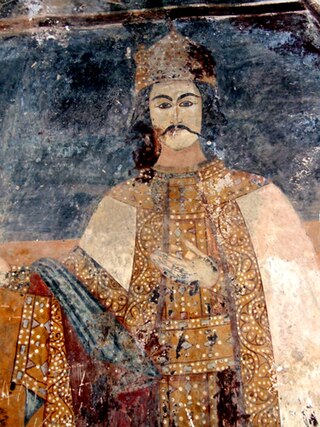Direct descendants through the elder legitimate line from Aslan Bey Sharvashidze

The House of Dadiani, later known as the House of Dadiani-Chikovani, was a Georgian family of nobles, dukes and princes, and a ruling dynasty of the western Georgian province of Mingrelia.

Bagrat III (1495-1565), of the Bagrationi dynasty, was a king (mepe) of Imereti from April 1, 1510, to 1565. He succeeded upon the death of his father, Alexander II, and faced repeated assaults from the Ottoman Turks as well as the conflicts with his ostensible vassal princes of Mingrelia, Guria, and Abkhazia who were frequently joining the enemy.

The House of Gurieli was a Georgian princely (mtavari) family and a ruling dynasty (dukes) of the southwestern Georgian province of Guria, which was autonomous and later, for a few centuries, independent. A few ducal rulers of the dynasty also rose in the 17th-18th centuries to be kings of the whole western Caucasus in place of the hereditary Bagrationi kings of Imereti.
Giorgi III Gurieli, of the Georgian House of Gurieli, was Prince of Guria from 1669 to 1684 and King of Imereti from 1681 to 1683. He was energetically involved in civil wars in western Georgian polities, which he sought to bring under his sway. He was killed in battle while trying to recover the lost throne of Imereti.

The Samtskhe-Saatabago or Samtskhe Atabegate, also called the Principality of Samtskhe, was a Georgian feudal principality in Zemo Kartli, ruled by an atabeg (tutor) of Georgia for nearly three and a half centuries, between 1268 and 1625. Its territory consisted of the modern-day Samtskhe-Javakheti region and the historical region of Tao-Klarjeti.

The Kingdom of Kartli was a late medieval/early modern monarchy in eastern Georgia, centred on the province of Kartli, with its capital at Tbilisi. It emerged in the process of a tripartite division of the Kingdom of Georgia in 1478 and existed, with several brief intervals, until 1762 when Kartli and the neighbouring Georgian kingdom of Kakheti were merged through dynastic succession under the Kakhetian branch of the Bagrationi dynasty. Through much of this period, the kingdom was a vassal of the successive dynasties of Iran, and to a much shorter period Ottoman Empire, but enjoyed intermittent periods of greater independence, especially after 1747.

Mariam Dadiani was a daughter of Manuchar I Dadiani, Prince of Mingrelia, by his second wife, Tamar Jaqeli. Thrice married, successively to Simon I Gurieli, Prince of Guria, in 1621, King Rostom of Kartli in 1638, and the latter's adopted son and successor, King Vakhtang V in 1658.

Levan I Dadiani was a member of the House of Dadiani and ruler of Odishi, that is, Mingrelia, in western Georgia. He succeeded on the death of his father, Mamia III Dadiani, as eristavi ("duke") of Odishi and ex officio mandaturt-ukhutsesi of Imereti in 1533. Dadiani's break with the king of Imereti brought about his downfall and imprisonment in 1546. He was able to escape and regain his possessions, securing Ottoman support for his independence from Imereti.
Mamia IV Dadiani was Prince of Mingrelia, of the House of Dadiani, from 1573 to 1578 and again from 1582 until his death. He was a younger son of Levan I Dadiani.

Manuchar I Dadiani was Prince of Mingrelia, of the House of Dadiani, from 1590 until his death. A younger son of Levan I Dadiani, he succeeded on the death of his elder brother, Mamia IV Dadiani.
Kaikhosro II Jaqeli, of the House of Jaqeli, son of Qvarqvare III, was prince of Samtskhe, ruling nominally in 1545–1573. Invested as a puppet ruler by the Ottomans in 1545, Kaikhosro II's tenure was marred by incessant Iranian–Ottoman rivalry, as well as uneasy relations with neighboring Georgian polities, and internecine feuds. The western part of his principality became quickly assimilated by the Ottomans and formed into a paşalık, while the eastern part came under Iranian suzerainty. In 1570, as a result of continued Ottoman aggression, Kaikhosro was forced to seek direct assistance from his suzerain king Tahmasp I at the Iranian royal court, where he died three years later as well.

Levan II Dadiani was a member of the House of Dadiani and ruler of the Principality of Mingrelia in western Georgia. Levan is known for his extensive raiding of neighboring countries and taking hostages for ransom.

Liparit III Dadiani was Prince of Mingrelia, of the House of Dadiani, from 1657 until being deposed in 1658.

Vameq III Dadiani was Prince of Mingrelia, of the House of Dadiani, from 1658 until being deposed in 1661. He was also briefly King of Imereti in 1661. He assumed both Mingrelian and Imeretian thrones and lost them during a messy civil war in western Georgian polities and was killed by assassins while hiding in a refuge of the mountains of Svaneti.
Grigol Dadiani, of the House of Dadiani, was Prince of Mingrelia from 1788 to 1804, with intermissions from 1791 to 1794 and in 1802 when his position was filled by his rivaling brothers. His rule was marred by the long-standing struggle between the Imeretian crown seeking to subdue Mingrelia and Mingrelian efforts to win full independence, a continuation of the conflict which had plagued western Georgia for centuries. Grigol's rapprochement with the expanding Russian Empire resulted in Mingrelia becoming, in 1804, a Russian subject with a degree of internal autonomy under the Dadiani dynasty, an arrangement which remained in place until 1856.
Rostom Gurieli, of the House of Gurieli, was Prince of Guria from 1534 until his death in 1564. Alongside his royal suzerain, Bagrat III of Imereti, Rostom fought against the expanding Ottoman Empire to which he lost parts of his principality. Rostom's relations with Bagrat III subsequently deteriorated over his support to the king's defiant vassal, Levan I Dadiani.
Giorgi II Gurieli, of the House of Gurieli, was Prince of Guria from 1564 to 1583 and again from 1587 to 1600. Succeeding on the death of his father Rostom Gurieli, Giorgi's rule over his small principality, located in southwest Georgia, was a period of conflict with the neighboring Dadiani of Mingrelia and increasing assertiveness of the Ottomans whom Gurieli submitted in 1581. His reign was interrupted, from 1583 to 1587, by a Mingrelian invasion, but Giorgi was able to resume the throne with Ottoman support.
Vakhtang I Gurieli, of the House of Gurieli, was Prince of Guria from 1583 to 1587. He ruled Guria, a small state in southwestern Georgia, as a client of Mamia IV Dadiani, Prince of Mingrelia, who had deposed Giorgi II Gurieli. Vakhtang was one of the sponsors of the Shemokmedi Monastery, Guria's principal cathedral.

Mamia II Gurieli (-1625/1627) is a 17th-century Georgian prince that ruled over the Principality of Guria in Western Georgia. Son of Prince George II, he succeeded his father in 1600 after spending a decade as head of Gurian troops. As Prince, he distinguished himself as a staunch supporter of closer relations with other Georgian states and an enemy of the Ottoman Empire. However, his policy failed as he was forced to remain under Turkish influence, while his ties with the Kingdom of Imereti progressively declined until an armed conflict and his assassination in 1625.
Kaikhosro I Gurieli, of the House of Gurieli, was Prince of Guria from 1626 to 1658. He was installed by Levan II Dadiani, Prince of Mingrelia, in place of his deposed predecessor Simon I Gurieli. In his turn, Kaikhosro was overthrown and expelled by King Alexander III of Imereti. His comeback to Guria, in an Ottoman-supported endeavor, concluded with his assassination by a Gurian nobleman.